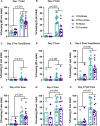Examining mGlu5 Receptor Availability as a Predictor of Vulnerability to PTSD: An [18F]FPEB and PET Study in Male and Female Rats
- PMID: 38024327
- PMCID: PMC10666551
- DOI: 10.1177/24705470231215001
Examining mGlu5 Receptor Availability as a Predictor of Vulnerability to PTSD: An [18F]FPEB and PET Study in Male and Female Rats
Abstract
Background: Females are twice as likely to experience post-traumatic stress disorder (PTSD) than males, yet specific factors contributing to this greater risk are not fully understood. Our clinical and recent preclinical findings suggest a role for the metabotropic glutamate receptor 5 (mGlu5) in PTSD and differential involvement between males and females.
Methods: Here, we further investigate whether mGlu5 receptor availability may contribute to individual and sex differences in PTSD susceptibility by quantifying receptor availability using the mGlu5 receptor-specific radiotracer, [18F]FPEB, and positron emission tomography in male (n = 16) and female (n = 16) rats before and after traumatic footshock exposure (FE) and assessment of stress-enhanced fear learning (SEFL) susceptibility, as compared with no-shock controls (CON; n = 7 male; n = 8 female).
Results: Overall, FE rats displayed greater fear generalization as compared with CON (p < .001). Further, greater mGlu5 receptor availability at baseline (p = .003) and post-test (p = .005) was significantly associated with expression of the SEFL phenotype. Notably, FE female rats displayed a shift to more passive coping (ie, freezing), and displayed greater SEFL susceptibility (p = .01), and had lower baseline mGlu5 availability (p = .03) relative to their FE male rat counterparts.
Conclusion: Results are consistent with clinical findings of higher mGlu5 receptor availability in PTSD, and add to growing evidence implicating these receptors in the pathophysiology of PTSD and sex-differences in susceptibility for this disorder.
Keywords: metabotropic glutamate receptor 5; positron emission tomography; post-traumatic stress disorder; sex-differences; stress-enhanced fear learning.
© The Author(s) 2023.
Conflict of interest statement
The authors declared no potential conflicts of interest with respect to the research, authorship, and/or publication of this article.
Figures




References
-
- American Psychiatric Association. Diagnostic and statistical manual of mental disorders (DSM-5). American Psychiatric Pub; 2013.
-
- Wamser-Nanney R, Howell KH, Schwartz LE, et al. The moderating role of trauma type on the relationship between event centrality of the traumatic experience and mental health outcomes. Psychol Trauma Theory Res Pract Policy. 2018;10:499. - PubMed
-
- Galatzer-Levy IR, Bryant RA. 636,120 Ways to have posttraumatic stress disorder. Perspectives on Psychol Sci. 2013;8:651‐662. - PubMed
Grants and funding
LinkOut - more resources
Full Text Sources

